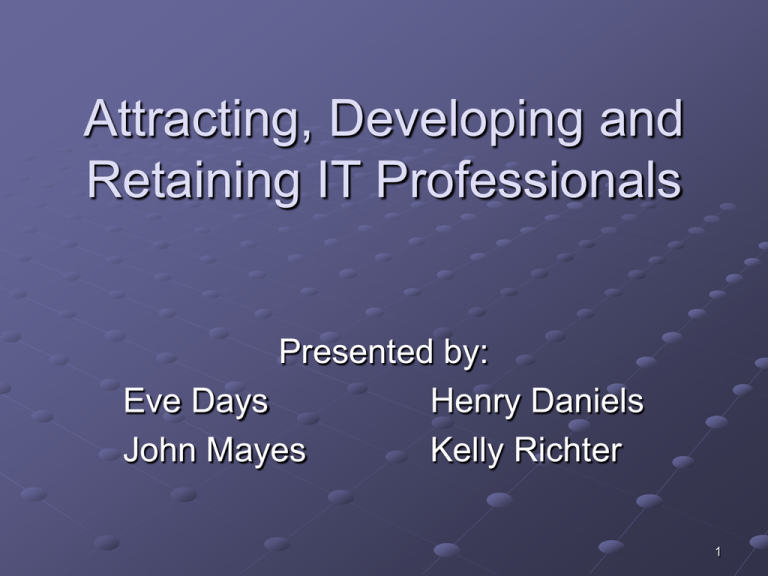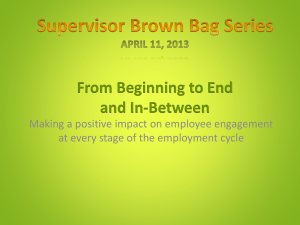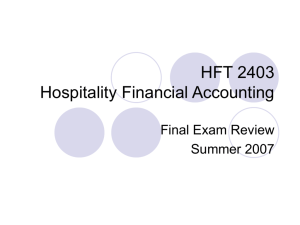Attracting, Developing and Retaining IT Professionals
advertisement

Attracting, Developing and Retaining IT Professionals Presented by: Eve Days Henry Daniels John Mayes Kelly Richter 1 Will Cover: Current trends of employment for Information Technology professionals in the U.S. Attracting IT professionals to your organization Developing the skills and expertise of IT professionals within your organization Suggestions for retaining IT professionals with your organization 2 Main Thoughts Common sense pay well, interesting work, current knowledge Awareness Goals of organization and individuals Competition 3 Background on Interviews Robert Bence, CIO St. Louis County Gov’t Public organization Michael Garcia, CPO Nexstar Financial Corp. Private organization 25 employees, plus 25-50 outsourced 25 in St. Louis, 65 in Colorado 4 Current Situation As of 2000, there was a shortage of 400,000 IT professionals in the US alone (1) The US Department of Commerce estimates that the US will require more than 1.3 million new and highly skilled IT workers through 2007 (2) 5 Perception and Qualifications Nerds or Not? (4) Spectrum of skills—what can you do for us? (5) Programming languages, database skills, operating systems, networking skills 6 Beginning the Attainment Process Tradition is not working any more Recruitment from all angles (7) (6) Recruiting Methods (survey of 150 executives from 1000 largest US firms) (3) Staffing/Recruiting 70% Posting Job on Company Website 57% Classified Advertising 35% Job Fairs 32% Electronic Matching Services 29% Referrals 21% Internships 2% 7 What Organizations Are Looking For and How They Hope to Get It Characteristics of the individual (6) Agreeableness, extroversion, conscientiousness, emotional stability, openness to experience Stealing from the competition—Greener pastures (8) “IT professionals with the most valued competencies are heavily recruited by organizations offering employment contracts with better salaries, along with signing bonuses, stock options and work culture inducements, including enhanced work arrangements and lifestyle accommodations.” Government problems –salary, image, and advancement (9) 8 What Organizations Are Looking For and How They Hope to Get It Human Resources as a partner (10) Managing legal risks, skills assessments, skills tracking, awareness of current trends Moving toward a business orientation (11) Blending technology and business 9 Attainment: Recruiting R. Bence (gov’t) All positions open to public (required) M. Garcia (private) In-house services Specific requirements General requirements 10 What IT Professionals Need To Be Big Picture Skills (12) Interpersonal, technical, business Activities (13) “identifying promising application targets, deciding the systems processes and modes of use, and assessing the systems risks and potential financial losses” Aspects (11) Diplomacy; political, interpersonal and business skills; reconsideration of traditional avenues of career development 11 Salary and Education Computer Systems Analysts and Scientists in 2004 (mean average) (14) Annual earnings: $63,694 average; $70,744 private Hours worked: 2,079 average; 2,083 private Hourly wage: $30.67 Education, 1999-2002 graduates in U.S. (15) 199900 200001 200102 IT Bachelor Bus. Bachelor IT Master Bus. Master IT Bus. Doctorate Doctorate 36,195 <3% 257,709 21% 14,264 3% 112,258 24.5% 777 <2% 1,196 <3% 41,954 >3% 265,746 21% 16,038 3% 116,475 25% 768 <2% 1,180 <3% 47,299 <4% 281,330 22% 16,113 3% 120,785 25% 750 <2% 1,158 <3% 12 Developing Through Training Training is a consistently crucial factor in the field of IT. Due to: Constant changes in society The ability to keeps costs low and stay competitive “Organizations have found increases in employees job satisfaction, productivity and profitability” (16) 13 To Train or Not to Train Benefits of Training Gives employees a sense of value and motivation Understanding how their role effects the organization Transfer learning to application Employee attitudes: “An individual might believe that acquiring object-oriented skills would likely provide a reward of being more marketable or earning a higher salary.” (16) 14 Costs of Training Keeping up to date in respect to technology can be very expensive (16) Explicit costs – additional funding for off-site training and on-site training In 1995, the average cost of retraining a programmer that earns $50,000 a year to be approximately $18,000 (17) Implicit costs – Lost hours of projected productivity Potential for the training not to “pay off”, referred to as transfer learning Employee Attitude – the individual might also believe that acquiring the object-oriented skills would be overly time consuming, requiring a significant amount of after hours study. 15 Transfer Learning Motivation to transfer involves the drive or inspiration of an individual to reassign knowledge gained from formal or informal learning to job-specific context Training is most effective when the employee feels that the employer will expect them to use that information in the near future The organization has a learning culture Trainees reported stronger transfer intentions when engaged in learning activities in which follow-up from their manager was anticipated or when employees were involved in training that was mandatory Other factors: Environmental, the utility of that which was learned, peer support, supervisor sanction and support (16) 16 Learning Organization Oticon: “Spaghetti Organization” Overall objective: Increase productivity by 30% The organization only supported three roles: Project managers – with overall responsibility for projects Senior Specialists – providing professional expertise in functional areas Coaches/Mentors – mentoring and other HR-related roles IT professionals learned through experience diplomacy, political, interpersonal, business (19) 17 Developing Through Evaluation Benefits: Evaluations are a very effective way to develop your employees. To get them off the wrong path and onto the right one. Cost: Evaluations, when done correctly, are time consuming. Focus on a game plan for the future, instead of the past. When possible, get feedback from employees 18 Developing Through Evaluations Be “S.M.A.R.T.” Specific Measurable Attainable Reflective Time bound 19 Developing Careers: Path R. Bence (gov’t) Primarily technical M. Garcia (private) Management vs. technical Silos…for now Teams Career and phase 20 Developing Careers: Training R. Bence (gov’t) Budget issues M. Garcia (private) Specific Status quo Tuition reimbursement Direct reports 21 Developing Careers: Performance Assessments R. Bence (gov’t) Annual M. Garcia (private) Every 6 months Formal Formal Future of assessments Coverage 22 Tommorow’s Jobs Between 2002 and 2012 total U. S. employment expected to increase by 14.8 percent Equates to 21 million more jobs Growth in professional, scientific, and technical services by 27.8 percent/1.9 million new jobs by 2012 (21) 23 Tomorrow’s Jobs Projections are that computer systems design and related services employment will increase 54.6 percent. This increase amounts to more than a third of all new jobs in the professional, scientific, and technical services job category. 632,000 new jobs are expected in the information supersector by 2012. This job sector includes software publishers, internet publishers, data processing services and internet service providers. (21) 24 What This May Mean To Organizations With IT Professionals Continued high turnover rates for IT professionals (22) Turnover rates of 25% - 33% in 1997-2001 period Average tenure in IT went down from 18 months in 1998 to 13 months Increased Competitiveness to fill IT positions (3) Poaching or brain snatching Headhunters Negative effects on innovation, productivity and competitiveness in world markets (27) 25 Turnover Percentages In Comparison (By Industry) Information technology Services Health care Banking and finance Insurance 25-33% 13.5 12.8 13.2 7.6 (23) 26 Turnover Percentages At the Best Companies To Work For (24) Rank Location Percentage 1 Wegman’s Food Markets 6 2 Starbucks 12 3 Valero Energy 29 4 Cisco Systems 3 5 Whole Food Market 32 13 A. G. Edwards 9 14 Microsoft 5 27 Managing IT Professionals Are IT professionals substantially different from other employees firms seek? Best practices for others good enough Differences IT vs. others IT skills and business skills Demand/supply constantly in flux Half-life of specific skills is short resulting in constant need for skill renewal and development (7) 28 What Successful IT Organizations Do Study of 32 organizations to determine what successful organizations do to recruit, develop and retain IT professionals Successful organizations being those successful in IT use, business performance or managing IT human resources (7) 29 Sample Demographics (7) Staff of Companies Included in Case Study: Number of IT Employees Percentage of Companies 100-1,000 50% <100 25% >1,000 25% 30 Recruiting Practices (7) Practice Category Frequency Sourcing 72 Skills Sought 8 Competitive 36 Differentiation Elements One-Time Inducements 6 31 Common Themes in IT Human Resource Trends Dedicated person or staff supporting IT Human Resource Activities Existence of diverse organizational cultures with two distinct dimensions being nurtured to some degree Productivity concerns dimension Interpersonal Dimension (7) 32 Retention Practices Increased frequency of performance appraisals with financial incentives Work arrangements with interesting and challenging projects Work arrangements that allowed rotation across jobs and projects Use of cross-functional teams and modifying work spaces to accommodate team work Processes for identifying training and development needs and addressing those needs (7) 33 Retention Practices Providing persistent and accurate counseling and feedback Flexible work arrangements Providing recognition and tangiable awards all through the performance period Birthday cards Welcome baskets Lunch or dinner out 34 Detailed IT Retention Practices (7) Practice Category Frequency (totaling 230) Performance Measurement 19 instances Compensation and Benefits Systems 44 Work Arrangements 27 Employability Training and Dev. 33 Longer-Term Career Development 9 Opportunities for Advancement 14 Opportunities for Recognition 15 Quality of Leadership 21 Sense of Community 32 Lifestyle Accommodations 13 Org. Stability and Employment Security 3 35 Using The Recruitment and Retention Practice Categories Examine current practices – benchmarking current practices against exemplary firms Helps to identify gaps in existing practice Use practice categories to determine set of practices to expend resources on to recruit and retain IT professionals (7) 36 Retaining R. Bence (gov’t) Autonomy M. Garcia (private) Autonomy Turnover Turnover Complaints Complaints 37 Retaining: Attractions R. Bence (gov’t) Security M. Garcia (private) Variety Commitment Team Visibility Incentives 38 The “Strategic Star” (7) 39 Closing Thoughts Common sense pay well, interesting work, current knowledge Awareness Goals of organization and individuals Competition 40 References 1. Kakabadse, Andrew and Nada Korac-Kakabadse, “Future Role of IS/IT Professionals,” The Journal of Management Development; 2000; 19, 2. 2. Kamal, Mustafa, “Information Technology Workforce—Planning for the Future,” Journal of American Academy of Business; Sep 2005; 7. 3. Amaram, Donatus I., “Issues in Recruitment and Retention for the IT Workforce,” The Journal of American Academy of Business; Mar 2005; 6, 2. 4. Kamal, Mustafa, “Information Technology Workforce—Planning for the Future,” Journal of American Academy of Business; Sep 2005; 7, 2. 5. Athey, Susan and John Plotnicki, “The Evaluation of Job Opportunities for IT Professionals,” The Journal of Computer Information Systems; Spring 1998; 38, 3. 6. Witt, L.A. and L.A. Burke, “Selecting High-Performing Information Technology Professionals,” Journal of End User Computing; Oct-Dec 2002; 14, 4. 41 References 7. Agarwal, Ritu and Thomas W. Ferratt, “Enduring Practices for Managing IT Professionals,” Communications of the ACM; Sep 2002; 45, 9. 8. Schambach, Thomas and J. Ellis Blanton, “The Professional Development Challenge for IT Professionals,” Communications of the ACM; Apr 2002; 35, 4. 9. Pawlowski, Suzanne D., Pratim Datta and Andrea L. Houston, “The (Gradually) Changing Face of State IT Jobs,” Communications of the ACM; May 2005; 48, 5. 10. Schwarzkopf, Albert B., Roberto J. Mejia, Jon Jasperson, Carol S. Saunders and Hermann Gruenwald, “Effective Practices for IT Skills Staffing,” Communications of the ACM; Jan 2004; 7, 1. 11. Kakabadse, Andrew and Nada Korac-Kakabadse, “Future Role of IS/IT Professionals,” The Journal of Management Development; 2000; 19, 2. 12. Agarwal, Ritu and Thomas W. Ferratt, “Enduring Practices for Managing IT Professionals,” Communications of the ACM; Sep 2002; 45, 9. 42 References 13. Pawlowski, Suzanne D., Pratim Datta and Andrea L. Houston, “The (Gradually) Changing Face of State IT Jobs,” Communications of the ACM; May 2005; 48, 5. 14. St. Louis National Compensation Survey, June 2004 15. US Department of Education 16. Ryan, Sherry D., “A Model of the Motivation for IT Retraining,” Information Resources Management Journal; Oct-Dec 1999; 12, 4. 17. Chabrow, 1995. 18. Egan, Toby Marshall, Baiyin Yang and Kenneth R. Bartlett, “The Effects of Organizational Learning Culture and Job Satisfaction on Motivation to Transfer Learning and Turnover Intention,” Human Resource Development Quarterly; Fall 2004; 15, 3. 19. Larsen, Henrik Holt, “Oticon: Unorthodox Project-Based Management and Careers in a Spaghetti Organization,” Human Resource Planning; 2002; 25, 4. 43 References 20. Lacity, Mary and Joseph Rottman, “St. Louis Regional Report on ‘Trends in IT Workforce Development;’” July, 2005. 21. U. S. Department of Labor, Bureau of Labor Statistics, Occupational Outlook Handbook, 2004-2005 22. Moore, Jo Ellen and Lisa A. Burke, “How to Turn Around ‘Turnover Culture’ in IT,” Communications of the ACM; Feb 2002; 45, 2. 23. “Why the Turnover Threat Is Real – and What to Do About It”; HR Focus; Aug. 2005; 82, 8. 24. “The Turnover Myth”; Workforce Management; Jun 2005; 84, 6. 25. “America’s New Deficit: The shortage of Information Technology Workers”, U. S. Department of Commerce, Office of Technology Policy, 1997, pp.19-21, viewed October 21, 2005. 44






